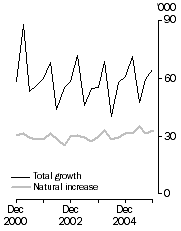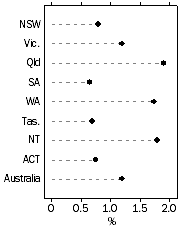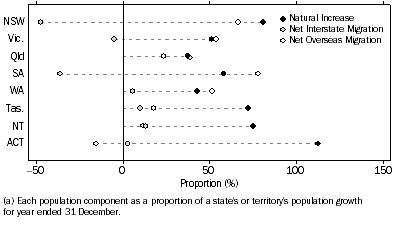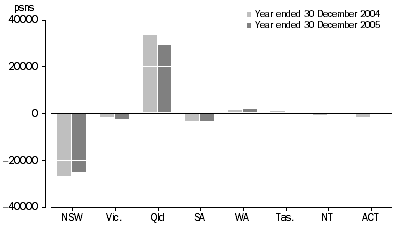DECEMBER KEY FIGURES
 | Population at end Dec qtr 2005 | Change over previous year | Change over previous year |  |
| PRELIMINARY DATA | '000 | '000 | % |  |
|  |
| New South Wales | 6 803.0 | 53.7 | 0.8 |  |
| Victoria | 5 052.4 | 59.7 | 1.2 |  |
| Queensland | 4 001.0 | 74.8 | 1.9 |  |
| South Australia | 1 546.3 | 9.9 | 0.6 |  |
| Western Australia | 2 028.7 | 34.7 | 1.7 |  |
| Tasmania | 487.2 | 3.4 | 0.7 |  |
| Northern Territory | 204.5 | 3.6 | 1.8 |  |
| Australian Capital Territory | 326.7 | 2.4 | 0.8 |  |
| Australia(a) | 20 452.3 | 242.3 | 1.2 |  |
|  |
| (a) Includes Other Territories comprising Jervis Bay Territory, Christmas Island and the Cocos (Keeling) Islands. |
Population growth, Quarterly

| Population growth rate, Year ended current quarter

|
DECEMBER KEY POINTS
ESTIMATED RESIDENT POPULATION
- The preliminary estimated resident population of Australia at 31 December 2005 was 20,452,300 persons, an increase of 242,300 persons (1.2%) since 31 December 2004.
- Preliminary natural increase for the year ended 31 December 2005 was 130,800 persons. This is an increase of 7.0% (or 8,600 persons) on the year ended 31 December 2004 (122,200).
- Preliminary net overseas migration during the December quarter 2005 was 31,100 persons, an increase of 10.9% (or 3,000 persons) on September quarter 2005, and an increase of 6.1% (or 1,800 persons) on December quarter 2004.
POPULATION GROWTH RATES
- The Australian population grew 1.2% during the year ended 31 December 2005. Natural increase and net overseas migration contributed 54% and 46% respectively to this total population growth.
- All states and territories experienced positive population growth during the 2005 calendar year. Queensland recorded the largest percentage gain (1.9% or 74,800 persons) and South Australia recorded the lowest (0.6% or 9,900 persons).
NOTES
FORTHCOMING ISSUES
| ISSUE (QUARTER) | Release Date |
| March 2006 | 21 September 2006 |
| June 2006 | 7 December 2006 |
| September 2006 | 22 March 2007 |
| December 2006 | 5 June 2007 |
| March 2007 | 24 September 2007 |
INTRODUCTION
Estimated resident population (ERP) data in this publication are based on the 2001 Census of Population and Housing. Exceptions are tables 17, 18 and 19 (excluding 2001 estimates), which are based on the 1996 Census of Population and Housing.
ERP DATA STATUS
At any point in time this publication contains final, revised and preliminary ERP data. The status of the ERP data included in this issue is as follows:
- Final - All ERP data up to and including June quarter 2001
- Revised - ERP data from September quarter 2001 to June quarter 2004, inclusive
- Preliminary - ERP data from September quarter 2004 to December quarter 2005, inclusive.
BIRTHS AND DEATHS DATA ADJUSTMENT
Births and deaths data for the December quarter 2005 have been adjusted to include updated data for the numbers of births and deaths registered over the three previous 2005 quarters (March, June and September) and updated data for deaths registered in September and December quarters 2004. Therefore, any data used for analysis from births, deaths, natural increase or population growth for the December quarter 2005 should be used with caution.
The standard annual revision to preliminary data (including births, deaths, natural increase and population growth) is scheduled for the next edition of this publication. Adjustments were applied to December quarter 2005 births and deaths registrations, rather than the correct quarters, to minimise confusion arising from undertaking two consecutive revisions. These adjustments were applied to this quarter to produce a more accurate estimated resident population at 31 December 2005. For further detail see paragraphs 8-14 of the Explanatory Notes.
DATA NOT YET AVAILABLE
Progress is continuing with the review of annual household estimates methodology. See Tables 17, 18 and 19. A new methodology has been proposed and is currently being assessed. Implementation details will be made available once this assessment is complete.
INQUIRIES
For further information about these and related statistics, contact the National Information and Referral Service on 1300 135 070 or Cassandra Eaves on Canberra (02) 6252 5640.
MAIN FEATURES
INTRODUCTION
The preliminary estimated resident population (ERP) of Australia at 31 December 2005 was 20,452,300 persons, an increase of 242,300 persons since 31 December 2004. The annual population growth rate (1.2%) was consistent with levels recorded in previous years.
COMPONENTS OF POPULATION CHANGE -AUSTRALIA
The growth of Australia's population has two components: natural increase (the number of births minus the number of deaths) and net overseas migration (net permanent and long-term movement).
Natural increase
Natural increase for the year ended 31 December 2005 was 130,800 persons. This represents an increase of 7.0% (or 8,600 persons) on the natural increase recorded for the year ended 31 December 2004 and is the highest natural increase figure recorded since 1994 (131,400). The number of births in 2005 (261,400) was 2.4% higher than in 2004 and was the highest number recorded annually since 1992 (262,100). Moreover, the number of births in 2005 was 2.7% higher than the number that would have been recorded if the observed 2004 age-specific fertility rates had been applied to the number of women of reproductive ages at 30 June 2005. Deaths decreased by 1.8% over the same period to remove 130,600 people from the population.
Births and deaths data for the December quarter 2005 have been adjusted. See paragraphs 8-14 of the Explanatory Notes for further detail.
Due to the collection and estimation method applied to produce these statistics, users should exercise caution when analysing and interpreting the most recent annual and quarterly births and deaths estimates, particularly when making time series comparisons. For analysis of fertility trends over time the Australian Bureau of Statistics (ABS) recommends users refer to Births, Australia (cat. no. 3301.0) . See paragraph 7 of the Explanatory Notes for more detail.
Net overseas migration
For the December quarter 2005, net overseas migration (NOM) was 31,100 persons, an increase of 6.1% (or 1,800 persons) on December quarter 2004.
For the year ended 31 December 2005, there were 442,100 permanent and long-term arrivals and 251,700 permanent and long-term departures. When combined with the migration adjustment these contributed to a net overseas migration of 111,600 persons. This was a 5.9% increase on the year ending 31 December 2004 (105,300).
The ABS applies a number of adjustments to the overseas arrivals and departures data used to produce estimates of NOM. These mainly comprise adjustments designed to reflect differences between stated travel intentions and actual travel behaviour, but (in the case of revised NOM estimates) also include adjustments to transform numbers of overseas movements into numbers of travellers. These are collectively referred to as 'migration adjustments'. For more information see the Technical Note - Measuring Net Overseas Migration.
STATES AND TERRITORIES
Population
Populations for the states and territories at 31 December 2005 were as follows: New South Wales 6,803,000, Victoria 5,052,400, Queensland 4,001,000, South Australia 1,546,300, Western Australia 2,028,700, Tasmania 487,200, the Northern Territory 204,500 and the Australian Capital Territory 326,700.
Queensland's population reached 4 million in December 2005, with the population growing by 74,800 persons (or 1.9%) over the year. The largest component of Queensland's population growth in 2005 was net interstate migration (38.8%), followed closely by natural increase (37.6%), while net overseas migration accounted for the remaining 23.6%.
Growth rates
All states and territories recorded positive population growth over the year ending 31 December 2005. Queensland recorded the fastest growth rate (1.9%), followed by the Northern Territory (1.8%), Western Australia (1.7%), Victoria (1.2%), New South Wales and the Australian Capital Territory (0.8%), Tasmania (0.7%) and South Australia (0.6%).
Population growth has slowed in Queensland, down from 2.1% in 2004 to 1.9% in 2005. Tasmania's growth rate has slowed marginally from 0.72% in 2004 to 0.70% in 2005. The greatest increase in population growth rates of all the states and territories for the year ended 31 December 2005 was the Northern Territory (up 0.72 percentage points), primarily due to the halt in net interstate migration losses.
COMPONENTS OF POPULATION CHANGE -STATES AND TERRITORIES
The growth of populations in the states and territories has three components: natural increase, net overseas migration and net interstate migration.
Although all states and territories experienced positive population growth in the year ended 31 December 2005, the impact and proportion of each component varied between the states and territories.
Population components(a), Year ended 31 December - States and territories - 2005

Natural increase
For the year ended 31 December 2005, natural increase was the major component of population growth, in the Australian Capital Territory (2,800 persons), New South Wales (43,500 persons), the Northern Territory (2,700 persons) and Tasmania (2,400 persons).
Net overseas migration
Net overseas migration was the major component of population growth (for the year ended 31 December 2005) in South Australia (7,800 persons), Victoria (32,100 persons) and Western Australia (17,800 persons). Positive net overseas migration was experienced by all other states and territories except the Australian Capital Territory which lost a net 380 persons.
Net interstate migration
During the December quarter 2005, Queensland, the Australian Capital Territory, Western Australia and Tasmania recorded net interstate migration gains, while New South Wales, South Australia, Victoria and the Northern Territory recorded net losses.
Net interstate migration was the largest contributor to Queensland's population growth for the year ended 31 December 2005, with an increase of 29,000 persons. Other states and territories to experience positive net interstate migration were Western Australia (2,000 persons), the Northern Territory (480 persons), Tasmania (340 persons) and the Australian Capital Territory (70 persons). Negative net interstate migration was experienced by New South Wales (-25,400 persons), South Australia (-3,600 persons) and Victoria (-2,900 persons).
NET INTERSTATE MIGRATION, States and territories

 Print Page
Print Page
 Print All
Print All